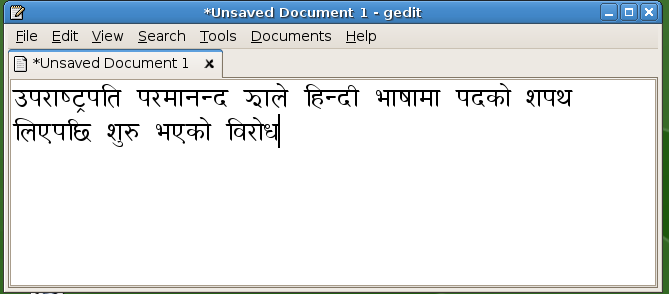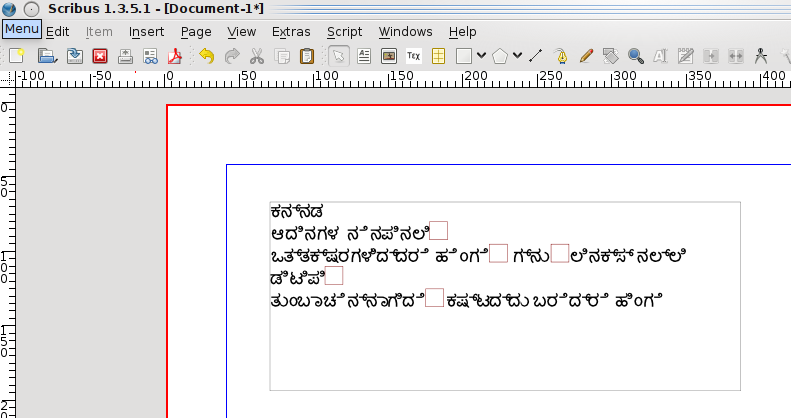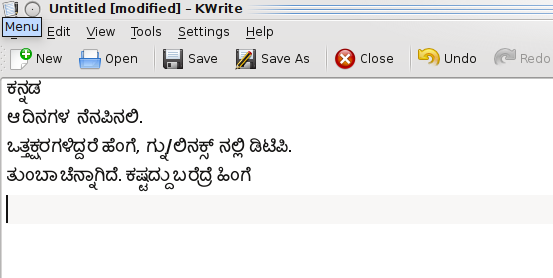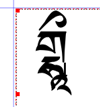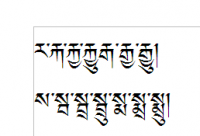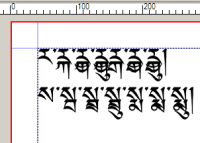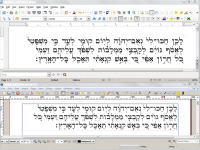Complex Script Functionality: Difference between revisions
m (→Gujarati: Reformatted) |
m (→Devanagari: displayed screenshot + reformatted) |
||
| Line 48: | Line 48: | ||
==Devanagari== | ==Devanagari== | ||
<big>The Devanagari script is used for writing many languages in India and Nepal including Sanskrit, Hindi and Nepali.</big> | |||
===Fonts=== | |||
* [http://www.sanskritweb.org/cakram/ Chandas] - Devanagari Unicode Open Type font with 4347 glyphs: 325 half-forms, 960 half-forms context-variations, 2743 ligature-signs. It is designed especially for Vedic and Classical Sanskrit but can also be used for Hindi, Nepali and other modern Indian languages. The font includes Vedic accents and many additional signs and so provides maximal support for Devanagari script. GPL License. | * [http://www.sanskritweb.org/cakram/ Chandas] - Devanagari Unicode Open Type font with 4347 glyphs: 325 half-forms, 960 half-forms context-variations, 2743 ligature-signs. It is designed especially for Vedic and Classical Sanskrit but can also be used for Hindi, Nepali and other modern Indian languages. The font includes Vedic accents and many additional signs and so provides maximal support for Devanagari script. GPL License. | ||
* [http://madanpuraskar.org/index.php?option=com_docman&task=doc_download&gid=18&Itemid=63 Madan] - Open Type font with Nepali glyphsets.Developed by Madan Puraskar Pustakalaya and released under GPL. | * [http://madanpuraskar.org/index.php?option=com_docman&task=doc_download&gid=18&Itemid=63 Madan] - Open Type font with Nepali glyphsets.Developed by Madan Puraskar Pustakalaya and released under GPL. | ||
===Language, Script & Language System tags=== | |||
* Bhojpuri:deva:BHO | * Bhojpuri:deva:BHO | ||
* Hindi:deva:HIN | * Hindi:deva:HIN | ||
| Line 64: | Line 63: | ||
'''OpenType features''' used for Devanagari script | '''OpenType features''' used for Devanagari script | ||
* See [http://www.microsoft.com/typography/otfntdev/devanot/features.aspx Developing OpenType Fonts for Devanagari Script] - at Microsoft Typography | * See [http://www.microsoft.com/typography/otfntdev/devanot/features.aspx Developing OpenType Fonts for Devanagari Script] - at Microsoft Typography | ||
===Screenshots=== | |||
[ | [[File:Rendering1.png|300x300px|framed|left|'''Current Rendering by Scribus''']] | ||
[ | [[File:Rendering2.png|400x400px|framed|left|'''Desired Rendering''']] | ||
==Gujarati== | ==Gujarati== | ||
Revision as of 22:19, 29 December 2013
This page relates to Bug 0001547: - Support for Indic Scripts and Metabug 0003965: Support for non-latin languages].
Things we require for testing Complex Script Functionality
- Sample text files encoded in UTF8
- Sample screenshots of Scribus 1.4.1 or 1.5.0svn rendering these incorrectly.
- Sample fonts that we can get that are freely available that have the ability to be used for DTP.
- Sample screenshots of any application rendering the same text correctly
- An important point to note is we need comparable information. Same texts, same fonts etc and screenshots (png or tiff please) of said texts and fonts. --Cbradney 18:40, 25 Feb 2005 (UTC)
- It would also be helpful to add information about the writing direction(s).--C schaefer (talk) 06:52, 22 December 2012 (CET)
- Other useful contribution would be mapping of the languages you're interested in with its script/lang pair in OpenType Font style.
example : French:latn:FRA
To help, you can have a look at http://www.microsoft.com/typography/developers/OpenType/scripttags.aspx for script tags and http://www.microsoft.com/typography/developers/OpenType/languagetags.aspx for lang tags. --Pmarchand 13:46, 8 April 2007 (CEST)
Please try to only list the best fonts for each script for use in printed publications. (Not screen/web fonts).
I don't know anything about quality, but Fedora 9 has many of these fonts available in their repository (meaning they must be free): arabic, bengali, gujarati, hindi, malayalam, oriya, punjabi, sinhala, tamil, and telugu. – Greg P
Arabic & Urdu
Font: Free fonts for Arabic / Urdu are available by Crulp and by PakType. Licensing is GPL at PakType and Crulp has also very loose license.
Bengali
Font:
SolaimanLipi is a free Bengali font available in sourceforge
Language, Script & Language System tags:
- Assamese:beng:ASM
- Bengali:beng:BEN
Open Type features used for Bengali script
- See: Developing OpenType Fonts for Bengali Script - at MS Typography
Screenshots:
Please expand this section
Devanagari
The Devanagari script is used for writing many languages in India and Nepal including Sanskrit, Hindi and Nepali.
Fonts
- Chandas - Devanagari Unicode Open Type font with 4347 glyphs: 325 half-forms, 960 half-forms context-variations, 2743 ligature-signs. It is designed especially for Vedic and Classical Sanskrit but can also be used for Hindi, Nepali and other modern Indian languages. The font includes Vedic accents and many additional signs and so provides maximal support for Devanagari script. GPL License.
- Madan - Open Type font with Nepali glyphsets.Developed by Madan Puraskar Pustakalaya and released under GPL.
Language, Script & Language System tags
- Bhojpuri:deva:BHO
- Hindi:deva:HIN
- Marathi:deva:MAR
- Nepali:deva:NEP
- Sanskrit:deva:SAN
OpenType features used for Devanagari script
- See Developing OpenType Fonts for Devanagari Script - at Microsoft Typography
Screenshots
Gujarati
Please expand this section
Fonts
Language, Script & Language System tags
Screenshots
Kannada
Kannada is used in south India
Fonts
Lohit Kannada https://fedorahosted.org/lohit (GPL Font)
Language, Script & Language System tags
Kannada KAN
Screenshots
Khmer
- Khmer is used in Cambodia.
Fonts:
- Khmer OS System: http://selapa.net/khmerfonts/fontinfo.php?font=89
- Other Khmer font: http://selapa.net/khmerfonts/
Language, Script & Language System tags:
- Khmer KHM
Screenshots:
Scribus rendering (incorrect):
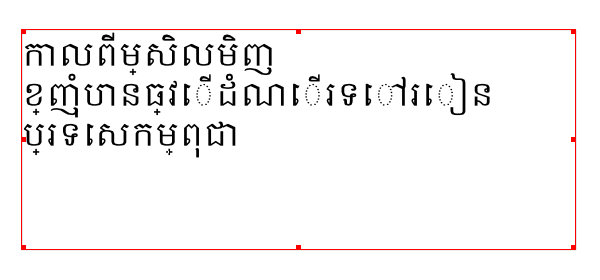
gEdit rendering (correct):
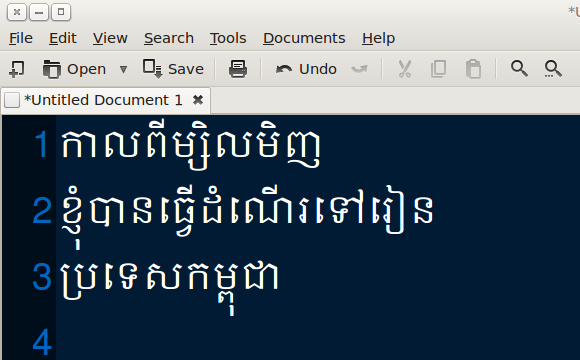
Lao
- Please expand this section
Fonts:
Language, Script & Language System tags:
Screenshots:
Malayalam
- The issue is related to the bug report http://bugs.scribus.net/view.php?id=7140
Fonts:
Lohit Malayalam https://fedorahosted.org/lohit , AnjaliOldLipi http://varamozhi.sourceforge.net/fonts/AnjaliOldLipi-0.710.ttf (GPL fonts)
Language, Script & Language System tags:
Malayalam MAL
Screenshots:
Scribus rendering
 Desired Rendering
Desired Rendering

Myanmar
Please expand this section
Font:
Language, Script & Language System tags:
- Burmese:mymr:BRM
OpenType Features used for Myanmar script:
Screenshots:
Oriya
Font:
Language, Script & Language System tags:
- Oriya:orya:ori
Open Type features used for Oriya script
- See: Developing OpenType Fonts for Oriya Script - at MS Typography
Screenshots:
Scribus rendering
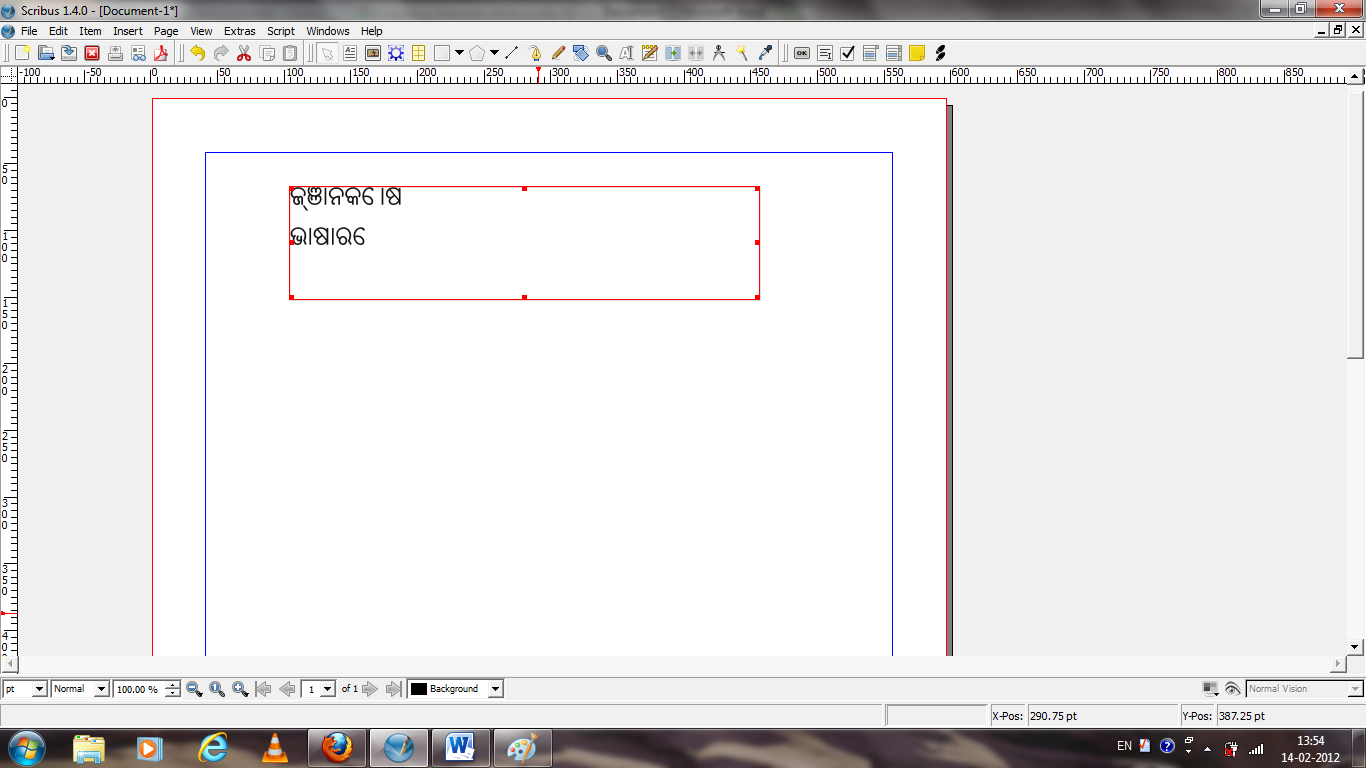 Desired Rendering
Desired Rendering
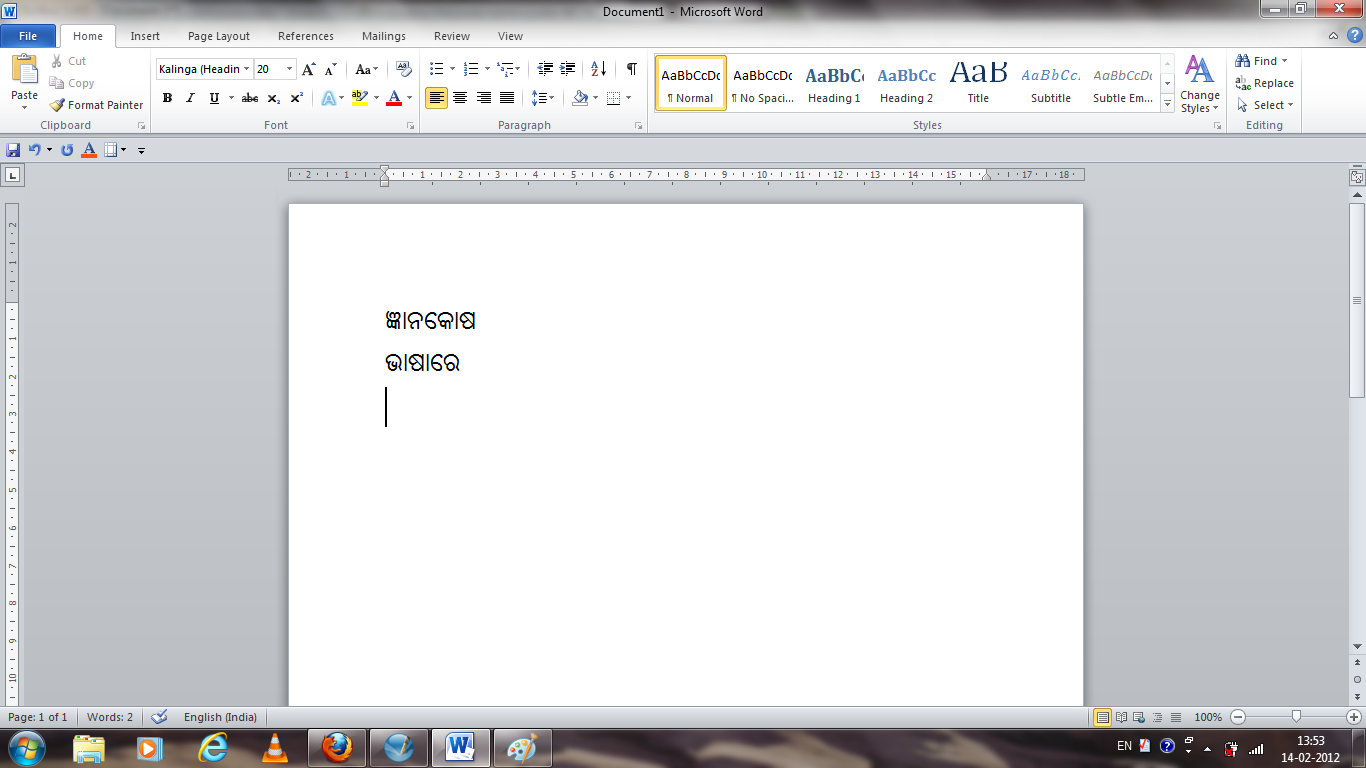 UTF8:
<utf8>ଜ୍ଞାନକୋଷ
ଭାଷାରେ
</utf8>
UTF8:
<utf8>ଜ୍ଞାନକୋଷ
ଭାଷାରେ
</utf8>
Sinhala
Fonts:
- Unicode Range: 0D80 - 0DFF SInhala Unicode Range
- Fonts freely available in both Linux and MS Windows from here
- Typing order: Left ==> Right
Language, Script & Language System tags:
Screenshots:
- Sinhala Unicode Issues for Scribus Version 1.3.3.12
- Issues in MS Windows
- Issues in MS Windows
1. Not Supporting for Sinhala Charters
- Example Charters
අ 0D85 , ෆ 0DC6 ......
- Issues in Linux
- Sinhala Unicode Issues for Scribus Version 1.3.6SVN
- Issues in MS Windows
- Issues in MS Windows
- Scribus rendering http://wiki.scribus.net/index.php/Image:Scribus_1.3.6svn(ms_windows)-sinhala.png
- Desired Rendering http://wiki.scribus.net/index.php/Image:Notepad-Sinhala.png
- Scribus rendering http://wiki.scribus.net/index.php/Image:Scribus_1.3.6svn(ms_windows)-sinhala.png
- Issues in Linux
Tamil
- Please expand this section
Fonts:
Language, Script & Language System tags:
Screenshots:
Telugu
- Please expand this section
Fonts:
Language, Script & Language System tags:
Screenshots:
Thai
- Please expand this section
Fonts:
Seems to work fine on a variety of fonts (compiled for OSX), including the following:
- JS-Jukaphan
- PSLxText
- PSL TextSP
- Thonburi (OSX default font for Thai)
- TH Krub
- TH K2D July8
Note: This does not work with Tahoma (the tone marks and vowels overlay each other)
Language, Script & Language System tags:
Screenshots:
Tibetan & Dzongkha
This relates to Bug 0004452: No support for Tibetan Script - sample UTF-8 test file and PDF file attached to that bug.
Tibetan Script:
- Unicode Range: 0F00 - 0FFF Tibetan Unicode Range
- Typing order: Left ==> Right
- OpenType Specs: Creating and Supporting OpenType Fonts for Tibetan Script
Fonts:
- Jomolhari, a free Tibetan script font suitable for publishing is available from the Free Tibetan Fonts project - OFL License. The font was originally designed for publishing traditional Buddhist texts in Classical Tibetan (chos skad) - but can also be used for modern Tibetan, Dzongkha and Ladakhi text. The font works well in OO.org 2.4.x & Inkscape.
- DDC Uchen OFL License. Freely available from the Dzongkha Development Commission
Language Script & Language System tags:
- Tibetan: tibt:dflt (default)
- Tibetan: tibt:TIB
- Dzongkha: tibt:DZN
- Sanskrit: tibt:SAN
- Ladakhi: tibt:LDK
- Tshangla: tibt:TSJ
- Khengkha: tibt:XKF
- Bumthangkha: tibt:KJZ
- Balti: tibt:BFT
OpenType Features
The following OpenType features should be processed to support Tibetan script:
- ccmp - Glyph Composition / Decomposition (Composition = GSUB lookup type 4 & Decomposition = GSUB lookup type 2).
- blws - Below-base Substitutions (GSUB lookup type 4)
- abvs - Above-base Substitutions (GSUB lookup type 4)
- calt - Contextual Alternates (GSUB lookup type 6)
- blwm - Below-base Mark Positioning (GPOS lookup type 4,5)
- abvm - Above-base Mark Positioning (GPOS lookup type 4,5)
- kern - Kerning - (GPOS lookup type 2 or 8)
Note: The current version of the Jomolhari font uses only ccmp, blws, abvs, calt, and kern features. In kern only GPOS lookup type 2 (pair-adjustment) is used in this font ~ so this is the only kind of GPOS lookup used.
Tibetan Script Rendering Examples:
Test of ccmp feature used for Decomposition (GSUB lookup type 2):
The string U+0F43 U+0F77 (གྷཷ) should render like the first example:
In this case, the ccmp feature should decompose U+0F77 into seperate glyph components to go below and above the glyph for the base character (U+0F43)
Test of ccmp feature used for Composition (GSUB lookup type 4):
The string U+0F42 U+0FB7 U+0F0B U+0F4C U+0FB7 U+0F0B U+0F51 U+0FB7 U+0F0B U+0F56 U+0FB7 U+0F0B U+0F5B U+0FB7 U+0F0B U+0F40 U+0FB5 (གྷ་ཌྷ་དྷ་བྷ་ཛྷ་ཀྵ) should render as follows:
Furthermore, the strings U+0F42 U+0FB7 U+0F0B U+0F4C U+0FB7 U+0F0B U+0F51 U+0FB7 U+0F0B U+0F56 U+0FB7 U+0F0B U+0F5B U+0FB7 U+0F0B U+0F40 U+0FB5 (གྷ་ཌྷ་དྷ་བྷ་ཛྷ་ཀྵ) and U+0F43 U+0F0B U+0F4D U+0F0B U+0F52 U+0F0B U+0F57 U+0F0B U+0F5C U+0F0B U+0F69 (གྷ་ཌྷ་དྷ་བྷ་ཛྷ་ཀྵ) should render identically as they are canonically equivalent. (U+0F42 U+0FB7 = U+0F43; U+0F4C U+0FB7 = U+0F4D; U+0F51 U+0FB7 = U+0F52; U+0F5B U+0FB7 = U+0F5C; and U+0F40 U+0FB5 = U+0F69.)
Test of blws feature (GSUB lookup type 4)
Test string consists of the folowing Unicode characters:
U+0F62 U+0F0B U+0F62 U+0F90 U+0F0B U+0F62 U+0F90 U+0FB1 U+0F0B U+0F62 U+0F90 U+0FB1 U+0F74 U+0F62 U+0F92 U+0F0B U+0F62 U+0F92 U+0FB1 U+0F0B U+0F62 U+0F92 U+0FB1 U+0F74 U+0F0D (ར་རྐ་རྐྱ་རྐྱུརྒ་རྒྱ་རྒྱུ།) and
Test of abvs feature (GSUB lookup type 4)
Hebrew with vowels and cantillation
UTF8 Hebrew Text
A pangram of Hebrew text (from Zephania 3:8):
לָכֵ֤ן חַכּוּ־לִי֙ נְאֻם־יְהוָ֔ה לְי֖וֹם קוּמִ֣י לְעַ֑ד כִּ֣י מִשְׁפָּטִי֩ לֶאֱסֹ֨ף גּוֹיִ֜ם לְקָבְצִ֣י מַמְלָכ֗וֹת לִשְׁפֹּ֨ךְ עֲלֵיהֶ֤ם זַעְמִי֙ כֹּ֚ל חֲר֣וֹן אַפִּ֔י כִּ֚י בְּאֵ֣שׁ קִנְאָתִ֔י תֵּאָכֵ֖ל כָּל־הָאָֽרֶץ׃
Note: Hebrew script is written RTL (right to left). The above text is formatted with the following span and div tags:
<div dir="RTL"><span lang="he" xml:lang="he">
Scribus vs. LibreOffice Screenshot
Hebrew Fonts
- Unicode range: 0590–05FF
- Opentype script and laguage tags: Hebrew:hebr:IWR
- The Cardo font (Cardoi99.otf) by Fonts for Scholars is an open source licensed Open Type font that includes the full set of Hebrew with its diacritics
- The Open Source Unicode Hebrew Font pack (A comprehensive collection of free/libre licensed fonts including Ezra SIL, Cardo, and Culmus Project fonts)
- Ezra SIL (an open font licensed, Unicode Hebrew font supporting the full range of Hebrew diacritics)

